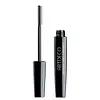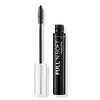What's inside
What's inside
 Key Ingredients
Key Ingredients

 Benefits
Benefits

 Concerns
Concerns

 Ingredients Side-by-side
Ingredients Side-by-side

Water
Skin ConditioningCopernicia Cerifera Wax
Stearic Acid
CleansingPvp
Emulsion StabilisingVp/Eicosene Copolymer
Glyceryl Stearate
EmollientPPG-25-Laureth-25
EmulsifyingRicinus Communis Seed Oil
MaskingPropylene Glycol
HumectantCera Microcristallina
Emulsion StabilisingSimethicone
EmollientCaprylyl Glycol
Emollient1,2-Hexanediol
Skin ConditioningHydroxyethylcellulose
Emulsion StabilisingPhenoxyethanol
PreservativeSodium Hydroxide
BufferingAcrylates Copolymer
Potassium Sorbate
PreservativeSilica
AbrasiveTocopheryl Acetate
AntioxidantEthylene/Methacrylate Copolymer
Ethylparaben
PreservativeMethylparaben
PreservativeGlycerin
HumectantPanthenol
Skin ConditioningTetrasodium EDTA
Propylparaben
PreservativeTropolone
Skin ConditioningIsopropyl Titanium Triisostearate
EmollientCI 77266
Cosmetic ColorantCI 77499
Cosmetic ColorantWater, Copernicia Cerifera Wax, Stearic Acid, Pvp, Vp/Eicosene Copolymer, Glyceryl Stearate, PPG-25-Laureth-25, Ricinus Communis Seed Oil, Propylene Glycol, Cera Microcristallina, Simethicone, Caprylyl Glycol, 1,2-Hexanediol, Hydroxyethylcellulose, Phenoxyethanol, Sodium Hydroxide, Acrylates Copolymer, Potassium Sorbate, Silica, Tocopheryl Acetate, Ethylene/Methacrylate Copolymer, Ethylparaben, Methylparaben, Glycerin, Panthenol, Tetrasodium EDTA, Propylparaben, Tropolone, Isopropyl Titanium Triisostearate, CI 77266, CI 77499
Water
Skin ConditioningBeeswax
Emulsion StabilisingCyclopentasiloxane
EmollientGlyceryl Stearate
EmollientPPG-17
Skin ConditioningCopernicia Cerifera Wax
Paraffin
PerfumingNylon-12
Polyethylene
AbrasiveButylene Glycol
HumectantPolymethyl Methacrylate
Stearic Acid
CleansingVp/Eicosene Copolymer
Triethanolamine
BufferingPalmitic Acid
EmollientPvp
Emulsion StabilisingSilica
AbrasiveSynthetic Wax
AbrasivePanthenol
Skin ConditioningDimethiconol
EmollientHydrolyzed Corn Starch
HumectantIsoceteth-20
EmulsifyingHydroxyethylcellulose
Emulsion StabilisingDiazolidinyl Urea
PreservativeMethylparaben
PreservativeDisodium EDTA
Simethicone
EmollientOctylacrylamide/Acrylates/Butylaminoethyl Methacrylate Copolymer
Tocopheryl Acetate
AntioxidantBHT
AntioxidantLecithin
EmollientIsopropyl Titanium Triisostearate
EmollientButylparaben
MaskingDisodium Cocoamphodiacetate
CleansingOleamide
2-Oleamido-1,3-Octadecanediol
Skin ConditioningPropylparaben
PreservativeCI 77492
Cosmetic ColorantCI 77499
Cosmetic ColorantCI 77491
Cosmetic ColorantCI 77007
Cosmetic ColorantMica
Cosmetic ColorantCI 77891
Cosmetic ColorantCI 75470
Cosmetic ColorantCI 77288
Cosmetic ColorantCI 77289
Cosmetic ColorantCI 77510
Cosmetic ColorantWater, Beeswax, Cyclopentasiloxane, Glyceryl Stearate, PPG-17, Copernicia Cerifera Wax, Paraffin, Nylon-12, Polyethylene, Butylene Glycol, Polymethyl Methacrylate, Stearic Acid, Vp/Eicosene Copolymer, Triethanolamine, Palmitic Acid, Pvp, Silica, Synthetic Wax, Panthenol, Dimethiconol, Hydrolyzed Corn Starch, Isoceteth-20, Hydroxyethylcellulose, Diazolidinyl Urea, Methylparaben, Disodium EDTA, Simethicone, Octylacrylamide/Acrylates/Butylaminoethyl Methacrylate Copolymer, Tocopheryl Acetate, BHT, Lecithin, Isopropyl Titanium Triisostearate, Butylparaben, Disodium Cocoamphodiacetate, Oleamide, 2-Oleamido-1,3-Octadecanediol, Propylparaben, CI 77492, CI 77499, CI 77491, CI 77007, Mica, CI 77891, CI 75470, CI 77288, CI 77289, CI 77510
Ingredients Explained
These ingredients are found in both products.
Ingredients higher up in an ingredient list are typically present in a larger amount.
Ci 77499 is also hydrated iron III oxide. It is created from mixing red and black iron oxides. This helps give shades of darkness to a product.
Iron III oxides are classified as inorganic chemicals for coloring.
Copernicia Cerifera Wax comes from a palm tree native to Brazil; another name for this ingredient is Carnauba Wax.
This ingredient is used to thicken texture and also leaves behind a film when applied.
Fun fact: This wax has the highest melting point of all natural waxes and low solubility.
Learn more about Copernicia Cerifera WaxGlyceryl Stearate is a mix of glycerin and stearic acid.
It is used to stabilize the mixing of water and oil ingredients. By preventing these ingredients from separating, it can help elongate shelf life. It can also help thicken the product's texture.
As an emollient, it helps soften skin and supports barrier-replenishing ingredients.
In cosmetics, Glyceryl Stearate is often made from vegetable oils or synthetically produced.
This ingredient may not be fungal-acne safe
Fun fact: The human body also creates Glyceryl Stearate naturally.
Learn more about Glyceryl StearateHydroxyethylcellulose is used to improve the texture of products. It is created from a chemical reaction involving ethylene oxide and alkali-cellulose. Cellulose is a sugar found in plant cell walls and help give plants structure.
This ingredient helps stabilize products by preventing ingredients from separating. It can also help thicken the texture of a product.
This ingredient can also be found in pill medicines to help our bodies digest other ingredients.
Learn more about HydroxyethylcelluloseIsopropyl Titanium Triisostearate isn't fungal acne safe.
Methylparaben is a preservative and is a paraben. It is used to prevent the growth of fungus, mold, and other harmful bacteria. Parabens are chemicals used as preservatives in both cosmetics and food.
Methylparaben can be synthetically created. It can also be found naturally in some fruits, such as blueberries.
Oftentimes, Methylparaben is combined with other parabens to help increase the shelf life.
The safety of Methylparaben is currently being studied. While ongoing studies are looking into the safety of parabens, the results have been very mixed. Some studies have not found Methylparaben to be harmful.
Learn more about MethylparabenPanthenol is a common ingredient that helps hydrate and soothe the skin. It is found naturally in our skin and hair.
There are two forms of panthenol: D and L.
D-panthenol is also known as dexpanthenol. Most cosmetics use dexpanthenol or a mixture of D and L-panthenol.
Panthenol is famous due to its ability to go deeper into the skin's layers. Using this ingredient has numerous pros (and no cons):
Like hyaluronic acid, panthenol is a humectant. Humectants are able to bind and hold large amounts of water to keep skin hydrated.
This ingredient works well for wound healing. It works by increasing tissue in the wound and helps close open wounds.
Once oxidized, panthenol converts to pantothenic acid. Panthothenic acid is found in all living cells.
This ingredient is also referred to as pro-vitamin B5.
Learn more about PanthenolPropylparaben is a preservative and is a paraben with antifungal and antimicrobial properties.
This ingredient can be naturally found in plants and insects, but most of it is synthetically manufactured for human use. In cosmetics, it is usually created by reacting para-aminobenzoic acid and propanol (an alcohol).
You can usually find this ingredient in water-based products.
Parabens have come under controversy due to the claim they are hormone disruptors. Studies show conflicting results. We recommend speaking with a professional if you have any concerns.
Propylparaben is commonly found in food, medicine, and cosmetics.
Learn more about PropylparabenPvp is a water-soluble synthetic polymer and common hairstyling ingredient. It is a film-forming ingredient and used to "hold" specific shapes of hair.
Pvp is less effective in high-humidity. It tends to draw moisture, but this moisture dismantles the structure and "hold".
Silica, also known as silicon dioxide, is a naturally occurring mineral. It is used as a fine, spherical, and porous powder in cosmetics.
Though it has exfoliant properties, the function of silica varies depending on the product.
The unique structure of silica enhances the spreadability and adds smoothness, making it a great texture enhancer.
It is also used as an active carrier, emulsifier, and mattifier due to its ability to absorb excess oil.
In some products, tiny microneedles called spicules are made from silica or hydrolyzed sponge. When you rub them in, they lightly polish away dead skin layers and enhance the penetration of active ingredients.
Learn more about SilicaSimethicone is a silicone. It is an emollient and used to reduce foaming in a product. It is also often used to coat sunscreen ingredients for better spreadability.
This ingredient is created by mixing dimethylpolysiloxane and hydrated silica.
Stearic Acid is a fatty acid. It is an emollient, emulsifier, and texture enhancer.
As an emollient, stearic acid helps soften skin. It aids the skin's protective barrier by preventing water loss. It also provides a gentle cleansing effect without stripping away natural oils.
Stearic acid may also be used to enhance the texture of products. It can add volume and stabilize ingredients such as water and oil. This can help water and oil ingredients from separating.
Sources of stearic acid include animal or vegetable fats/oils such as coconut or shea. It can be naturally found in butter, cocoa butter, shea butter, vegetable fats, and animal tallow.
This ingredient may not be Malassezia folliculitis, or fungal-acne safe.
Learn more about Stearic AcidTocopheryl Acetate is AKA Vitamin E. It is an antioxidant and protects your skin from free radicals. Free radicals damage the skin by breaking down collagen.
One study found using Tocopheryl Acetate with Vitamin C decreased the number of sunburned cells.
Tocopheryl Acetate is commonly found in both skincare and dietary supplements.
Learn more about Tocopheryl AcetateWe don't have a description for Vp/Eicosene Copolymer yet.
Water. It's the most common cosmetic ingredient of all. You'll usually see it at the top of ingredient lists, meaning that it makes up the largest part of the product.
So why is it so popular? Water most often acts as a solvent - this means that it helps dissolve other ingredients into the formulation.
You'll also recognize water as that liquid we all need to stay alive. If you see this, drink a glass of water. Stay hydrated!
Learn more about Water